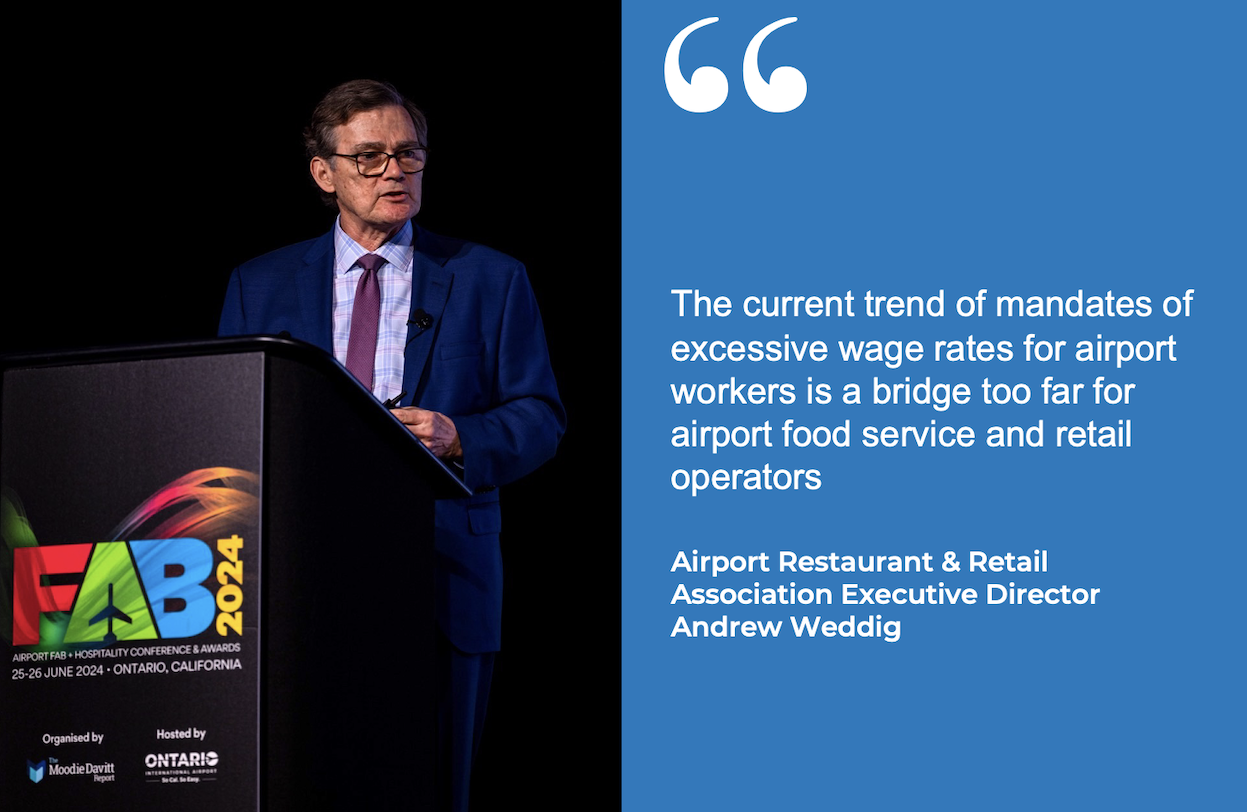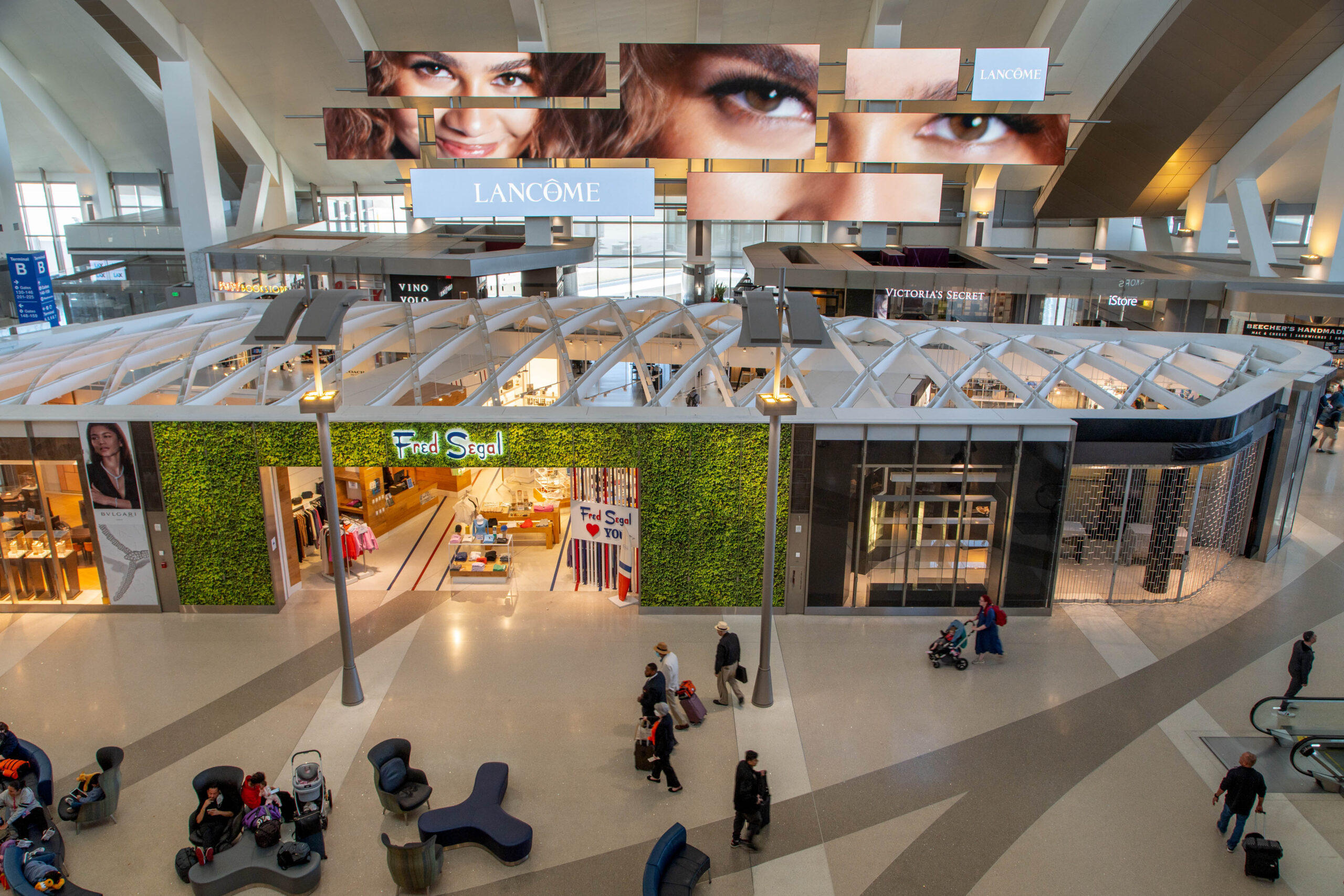Airport Restaurant & Retail Association (ARRA) Executive Director Andrew Weddig addresses the spiralling costs of airport concessions in the USA in this guest article, first sent to members last week. More on the association’s work appears below.
The City of Los Angeles is considering an amendment to its Living Wage Ordinance that would raise the minimum wage for service workers at Los Angeles International Airport (LAX) to US$25 an hour early next year followed by annual increases until the minimum wage reaches US$30 an hour in 2028, writes Andrew Weddig.
These rates represent an immediate +30% increase over the current living wage of US$19.25; the ultimate increase is +56% in less than four years.
But that’s not all. The proposed ordinance also increases the healthcare benefit to US$8.35 an hour from today’s US$5.95. In total, airport food service and retail operators face a +32% increase in the airport minimum wage mere months from now.

And these new minimum wages ignore that the increases don’t just stop there. Operators usually have to increase compensation for employees all the way up the seniority chart.
The impact is devastating. One ARRA member reports that passage of this ordinance would raise their labour costs by +70% over the next four years. No business can sustain this level of increase in a prime cost without offsets of some type.
Increases across the country
Los Angeles is not alone. Although LAX may represent the most extreme example, similar increases in airport wages have been implemented from coast to coast.
- In September, concession workers at Austin-Bergstrom International Airport agreed to a US$25 an hour minimum wage to avert a strike. The minimum had been US$20 since 2022.
- Moreover, the new minimum wage exceeds the City’s own living wage by more than +15%.
- The Metropolitan Washington Airports Authority established a base wage rate of US$16 for 2024 with an expected increase to US$16.78 per hour in 2025.
- The Port Authority of New York and New Jersey last month announced a cumulative US$1.50 per hour increase in the minimum wage during 2025, another 75 cents per hour in 2026, and then annual CPI increases between 2027 and 2032, reaching no less than US$25 in September 2032.
- The City of SeaTac’s minimum wage increased from US$19.06 to US$19.71 per hour for workers in hospitality and transportation, the highest rate in the state of Washington and +21% higher than the state’s minimum wage standard of US$16.28.
We recognise that airports are civic assets often used as vehicles for policy initiatives that may not apply throughout the community. But the current trend of mandates of excessive wage rates for airport workers is a bridge too far for airport food service and retail operators. And the two ultimate losers are our customers, as operators eventually pare back service to make ends meet.
More than mandates
Extraordinary minimum wage mandates are just part of the labour cost challenge. Airport wage rates have long exceeded streetside wages for comparable retail and food service positions.
Part of the wage premium is simply overcoming the reluctance of workers to take on the more difficult working conditions of an airport.

As explained by Riley Lagesen (Chair of Greenberg Traurig’s Global Restaurant Industry Group) in a 2022 ARRA Forum: “[Airports] have always been more complicated on the labour side than operating on the street… You’re looking at operating hours that are usually quite a bit longer. You’re looking at union labour, which is a huge differentiation, and you are looking at the ebb and flow of traffic at different periods and so forth. So, [in] comparison to a street, there’s no real relevant comparison to life in the airport. Food service operations [are] highly specialised and very different and should be considered as such.”
Rich Schneider, Chief Development Officer of Areas USA, added during the same Forum: “Transportation is a huge issue and being able to get [employees] to the airport … is different than the street. I think sometimes you have folks [at the airport] that are probably on 30 to 45 [or] 40 minutes to an hour to get to work, where on the street they might be able to get there in ten. I think it’s just an important challenge that the airport operators have, in addition to the period of going through the security clearance and all the things that you need to do.”
Moreover, as Lagesen noted, airport workers are overwhelmingly unionised in comparison to their streetside counterparts: ARRA’s recent member survey shows nearly 70% of concessions hourly associates are covered by collective bargaining agreements. This greatly exceeds union representation in the economy: in 2023, only 4.5% of retail workers and 1.6% of restaurant workers were represented by a union. The presence of unions generally leads to higher costs.
In the case of restaurants in the overall economy, union representation leads to 8% higher wages [1].
Finally, coming out of COVID, airport concessionaires – just like all lower-wage segments of the economy – endured tremendous labour shortages and consequent rapidly rising labour costs.

From 2021 through August 2024, ARRA members have increased their hourly associates’ wage rates +59%. [2]
And the increases are not just for our associates: increased wages for hourly associates trickle up to all workers. The 2024 ARRA member survey also found:
- Manager salaries have increased +52% from 2019 through August 2024.
- The cost of benefits per employee rose +27%
- Average hiring costs per new employee increased +14%.
- Total labour costs increased +30%.
Implications
ARRA members support liveable wages for their valued associates. But concessionaires’ businesses cannot sustain the current extraordinary growth in wages – mandated or otherwise – without offsets in either pricing or other costs.

Let’s face facts: Wage increases at airports are huge and significantly outpace wage growth on the street.
For example, where Los Angeles is considering a US$25 minimum wage at its airports, its city-wide minimum wage currently sits at US$17.28 per hour. The 2025 minimum wage for fast-food workers in New York City will be US$16.50 per hour, nearly -20% less than the new minimum wage at the Port Authority airports.[3]
From 2022 through August 2024, nationwide leisure and hospitality worker wage rates have increased +16%, compared to +59% for ARRA members.[4]
During the same period, prices at restaurants kept pace with labour rates on the street, but lagged far behind the increase in labour rates for concessionaires.[5]
This last fact is critical: most airport food service and retail operators face pricing restrictions based on street prices.
They simply cannot increase prices to keep pace with costs. More than 90% of respondents to ARRA’s 2024 member survey saw labour costs increase at a substantially greater pace than sales from 2019 through mid-2024.
The excessive growth of wages and salaries highlight why ARRA members, in the recent survey, stated labour costs are their most important current business challenge.
Solutions
What can we do? In the short term, allow cost recovery through relaxed pricing. Or offset rising labour costs with cost reductions elsewhere in the income statement. For example, Phoenix Sky Harbor International Airport, in 2019, eliminated street pricing restrictions and replaced them with market pricing. An Arizona Republic investigation found many restaurants enacted at least some price increases, but most were less than a dollar.[6] Moreover, the airport has reported no customer complaints.
The Port Authority of New York and New Jersey has matched its minimum wage increase with an increase in pricing from street +10% to street +15%, as well as an Employee Benefits & Retention surcharge of 3%.
On the cost side of the ledger, reducing rent rates to offset wage rate increases is appropriate, especially if the extraordinary wage increase is the result of an airport sponsor or other governmental action.
A big deal
Airport wage increases exceeding local market conditions are simply not sustainable for airport concessionaires. The current model has created an unlevel playing field that will decrease competition; push smaller, medium-sized and minority-owned businesses out of the market; and even make it harder in some cases for the legacy concessionaires to participate.
Most important, the customer experience will suffer: to financially survive without pricing or cost offsets, operators eventually must reduce service levels.
It’s vital that airports and concessionaires collaborate to find a solution to rising labour costs. Otherwise, the food & beverage and retail offerings we want to serve our joint customer, the travelling public, will deteriorate. Let’s figure out how to get this right to maintain the travel experience we have all come to expect.
About ARRA
The Airport Restaurant & Retail Association’s mission is to work collaboratively within the US aviation industry on business, operational and policy matters affecting airport food service and retail operators. As an organisation comprised of operators of all sizes and ownerships, it works in partnership with airports to promote the success of concessions businesses and enhance the passenger travel experience. For further information, please visit www.ARRA-airports.com.
This article first featured on the ARRA website. Click here for access. ✈
Sources:
1 “Union Members – 2023,” U.S. Bureau of Labor Statistics news release issued January 23, 2024.
2 ARRA 2024 member business survey.
3 New York State Department of Labor website (https://dol.ny.gov/minimum-wage-fast-food-workersfrequently-asked-questions)
4 U.S. Bureau of Labor Statistics, Average Hourly Earnings of Production and Nonsupervisory Employees, Leisure and Hospitality [CES7000000008], retrieved from FRED, Federal Reserve Bank of St. Louis; https://fred.stlouisfed.org/series/CES7000000008, November 13, 2024.
5 U.S. Bureau of Labor Statistics, Consumer Price Index for All Urban Consumers: Food Away from Home in U.S. City Average [CUSR0000SEFV], retrieved from FRED, Federal Reserve Bank of St. Louis; https://fred.stlouisfed.org/series/CUSR0000SEFV, November 13, 2024.
6 Melissa Yeager, “Phoenix airport restaurants: How much have prices gone up since street pricing ended?” The Arizona Republic, March 19, 2019, retrieved from azcentral.com, November 5, 2024.























